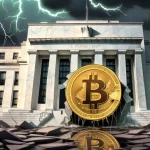US Debt Projected at 250% of GDP by 2100: Is Bitcoin the Ultimate Hedge?

US Debt Could Skyrocket to 250% of GDP by 2100: A Bitcoin Hedge in Waiting?
A bombshell paper from the Federal Reserve’s Jackson Hole summit claims the US could push its debt-to-GDP ratio—a measure of a country’s debt compared to its economic output—to a staggering 250% by the end of the century without interest rates spiking. That’s if demand for Treasury bonds stays rock-solid. But beneath this jaw-dropping projection lies a fiscal tightrope, and for Bitcoin and crypto advocates, it’s yet another signal that decentralized alternatives to fiat might be the ultimate lifeboat.
- Debt Forecast: US debt-to-GDP could hit 250% by 2100 without rate hikes, if investors keep buying Treasuries.
- Current Burden: Debt stands at 97% of GDP, with projections soaring due to recent laws.
- Fed’s Shift: Jerome Powell eyes rate cuts as jobs data weakens, ignoring sticky inflation.
The Debt Bomb: Can the US Really Handle 250%?
Presented at the prestigious Jackson Hole summit—an annual gathering of global central bankers in Wyoming—this research by economists Adrien Auclert (Stanford), Hannes Malmberg (University of Minnesota), Matthew Rognlie (Northwestern), and Ludwig Straub (Harvard) paints a wild picture. They argue that an aging population, desperate for safe assets like US Treasury bonds to secure retirement funds, could create enough demand to absorb massive government borrowing for decades. In essence, as long as retirees and cautious investors keep hoarding Treasuries, the US can stack debt to the moon without immediate pain in the form of higher interest rates.
“Until fiscal consolidation occurs, there will be a race between the rising asset demand of an older population and the rising debt issuance needed to finance the associated increase in government expenditures.” – Ludwig Straub
But Straub isn’t handing out blank checks. He’s blunt about the catch: this only works until it doesn’t. If the government keeps spending without slashing deficits or hiking taxes—a process called fiscal consolidation—debt supply will eventually swamp demand, forcing rates upward.
“Without large adjustments, the supply of debt will eventually outrun demand, forcing interest rates to rise.” – Ludwig Straub
Let’s ground this in reality. The US debt-to-GDP ratio is currently 97%, a hefty load that’s among the highest in history, only topped during World War II. The Congressional Budget Office (CBO) initially forecasted it hitting 117% by 2034, but recent legislation has tacked on nearly 10 more percentage points to that grim outlook. Interest payments alone cost the Treasury $1.2 trillion over the past year. If rates don’t drop, that could balloon to $1.4 trillion by 2026. To avoid this spiral, the 5-year Treasury yield needs to fall below 3.1% from its current 3.8%, requiring the Fed to cut rates by at least 75 basis points (a basis point is 1/100th of a percentage point, so 75 equals a 0.75% cut). And that’s exactly what might be on the horizon, according to a recent Fed analysis.
Fed’s Risky Pivot: Rate Cuts Amid Inflation Chaos
At the same summit, Fed Chair Jerome Powell dropped a hint that’s got markets buzzing—he’s shifting focus from inflation to jobs. After years of battling price spikes, with the Consumer Price Index (CPI) stuck above 2% for 53 months and core CPI over 3%, recent labor data has him spooked. Updates erased 258,000 jobs from May and June reports, with a whopping 461,000 wiped out in 2025 so far. That signals an economy weaker than previously thought, pushing unemployment into the spotlight over price stability, as detailed in Powell’s latest signals at Jackson Hole.
“The shifting balance of risks may warrant adjusting our policy stance.” – Jerome Powell
That’s code for rate cuts, and the Fed isn’t messing around—they’ve already slashed rates by 100 basis points in 2024 across multiple meetings. But here’s the rub: cutting rates while inflation still burns hot (producer price inflation just hit a 0.9% monthly jump, the highest since 2022) risks overheating asset markets. Data from Carson Research shows that when the Fed cuts rates with the S&P 500 near record highs, the index often gains 13.9% over the next 12 months. Great for stock owners, lousy for the average worker whose wages lag behind rising costs, widening the wealth gap further. And let’s not ignore the long game—low rates and persistent deficits could erode the dollar’s value over time, a slow bleed for fiat currency, with significant implications tied to US debt.
Historical Lessons: Is the US Japan or Greece?
Before we buy into the 250% debt fantasy, let’s look at history. Japan’s been sitting at over 250% debt-to-GDP for years without imploding. Why? Domestic investors snap up their bonds, and the yen holds safe-haven status. The US, with the dollar as the world’s reserve currency, has a similar edge—global demand for Treasuries remains unmatched, even with trillion-dollar deficits. But we’re not Japan. Our entitlement spending on Social Security and Medicare is a demographic time bomb, and unlike Japan’s cultural knack for saving, Americans lean on borrowing. Then there’s Greece—a cautionary tale. Their debt crisis in the 2010s, peaking at 180% of GDP, triggered bailouts and austerity after demand for their bonds collapsed. The US has more buffers, but political gridlock—where clowns can’t agree on lunch, let alone cutting a 10% GDP deficit—makes fiscal reform a fantasy. Delay too long, and as Straub warns, the debt becomes unsustainable, a point reinforced by detailed projections on debt trajectories.
“The longer this adjustment is delayed, the more government debt supply outstrips its demand, eventually making government debt unsustainable.” – Ludwig Straub
The Crypto Connection: Bitcoin and DeFi as Lifelines
For those of us in the crypto camp, this debt mess is like a neon sign flashing “fiat’s screwed.” Bitcoin, often dubbed digital gold, was forged in the aftermath of the 2008 financial crisis—a direct rebellion against centralized systems that pile on debt and print money to paper over cracks. A debt-to-GDP ratio creeping toward 250% isn’t just a number; it’s a warning of potential currency devaluation if trust in the dollar falters. Look at places like Argentina or Venezuela—when their fiat currencies tanked under debt and inflation, Bitcoin adoption spiked as folks sought a store of value outside government control. The US isn’t there yet, but with $1.2 trillion in annual interest payments already, the cracks are showing, sparking discussions on how debt impacts Bitcoin adoption.
Bitcoin maximalists might say this is BTC’s moment to shine as the ultimate hedge against fiat erosion, and I’m inclined to lean that way. But let’s not kid ourselves—Bitcoin isn’t a magic fix. It’s a store of value, not a daily payment system for most. That’s where other blockchains and altcoins step in. Ethereum, with its smart contract muscle, powers decentralized finance (DeFi)—think financial systems on the blockchain, no banks needed. Platforms like MakerDAO or Aave offer lending and savings options that could outpace traditional accounts in a low-rate, high-debt world. Stablecoins, whether pegged to assets or driven by algorithms, might also carve niches for those fleeing fiat volatility. The crypto space is diverse for a reason; Bitcoin can’t (and shouldn’t) solve every financial woe alone, a perspective echoed in conversations about Bitcoin’s role against debt crises.
Devil’s Advocate: Is This Debt Crisis Overblown?
Now, let’s flip the script and play skeptic. Is 250% debt-to-GDP really a death knell? The US dollar’s reserve status means global investors still see Treasuries as the safest bet, even with ballooning deficits. Demand could hold for decades, especially if no viable alternative emerges. Plus, the Fed’s aggressive 2024 rate cuts show they’re willing to keep borrowing costs low, buying time. And let’s not discount tech beyond crypto—automation or AI-driven productivity gains might offset debt burdens by juicing GDP growth. Even on the crypto side, Bitcoin faces hurdles: scalability limits, regulatory clampdowns, and energy debates could slow its rise as a mainstream hedge. Maybe the fiat system isn’t doomed just yet—or at least, not on a 2100 timeline. But betting on political will to fix a debt monster while entitlement costs explode? That’s a sucker’s wager, as some investors debate hedging with Bitcoin.
What Now for Crypto?
The Fed’s juggling a debt beast, inflation, and jobs, while fiscal responsibility remains a pipe dream. For crypto enthusiasts, this is a call to double down—keep building, keep pushing for systems that don’t hinge on central bankers or spendthrift governments. Bitcoin and DeFi aren’t just buzzwords; they’re potential escape hatches if the fiat house of cards collapses. Debt at 250% of GDP might not spike rates today, but it’s a hell of a gamble. What’s your backup plan if the dollar stumbles?
Key Takeaways and Questions for Crypto Enthusiasts
- How feasible is a 250% debt-to-GDP ratio for the US by 2100?
It’s possible if Treasury bond demand stays high due to an aging population, but it relies on fiscal adjustments that seem politically unattainable right now. - What are the dangers of delaying fiscal reform?
Without slashing the fiscal gap by at least 10% of GDP, debt supply could overwhelm demand, pushing interest rates up and risking unsustainable debt levels. - Why is the Fed pushing rate cuts despite persistent inflation?
Weak labor market data, with major job revisions, has shifted Powell’s priority to employment over price stability, leading to monetary easing in 2024. - How might rate cuts affect wealth inequality and crypto adoption?
Cuts could inflate asset markets, enriching the wealthy, while stagnant wages hurt most, potentially driving more to Bitcoin as a shield against fiat decline. - Why should crypto advocates care about soaring US debt?
Rising debt and possible currency devaluation expose fiat’s fragility, positioning Bitcoin and DeFi as crucial alternatives for financial independence. - How can DeFi address gaps in a debt-driven financial system?
DeFi platforms on Ethereum, like Aave or MakerDAO, offer decentralized lending and savings, bypassing traditional systems burdened by low rates and high debt.



